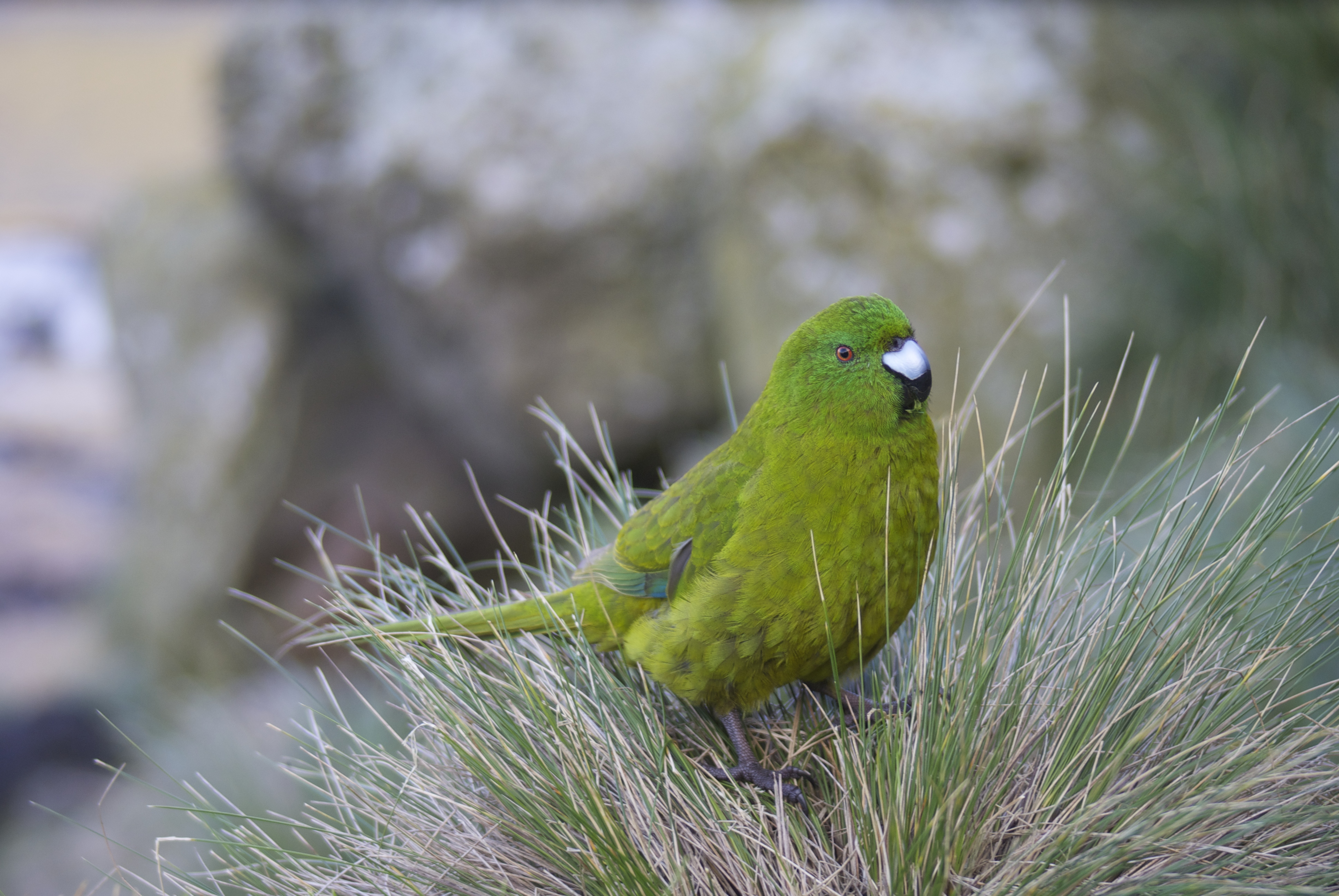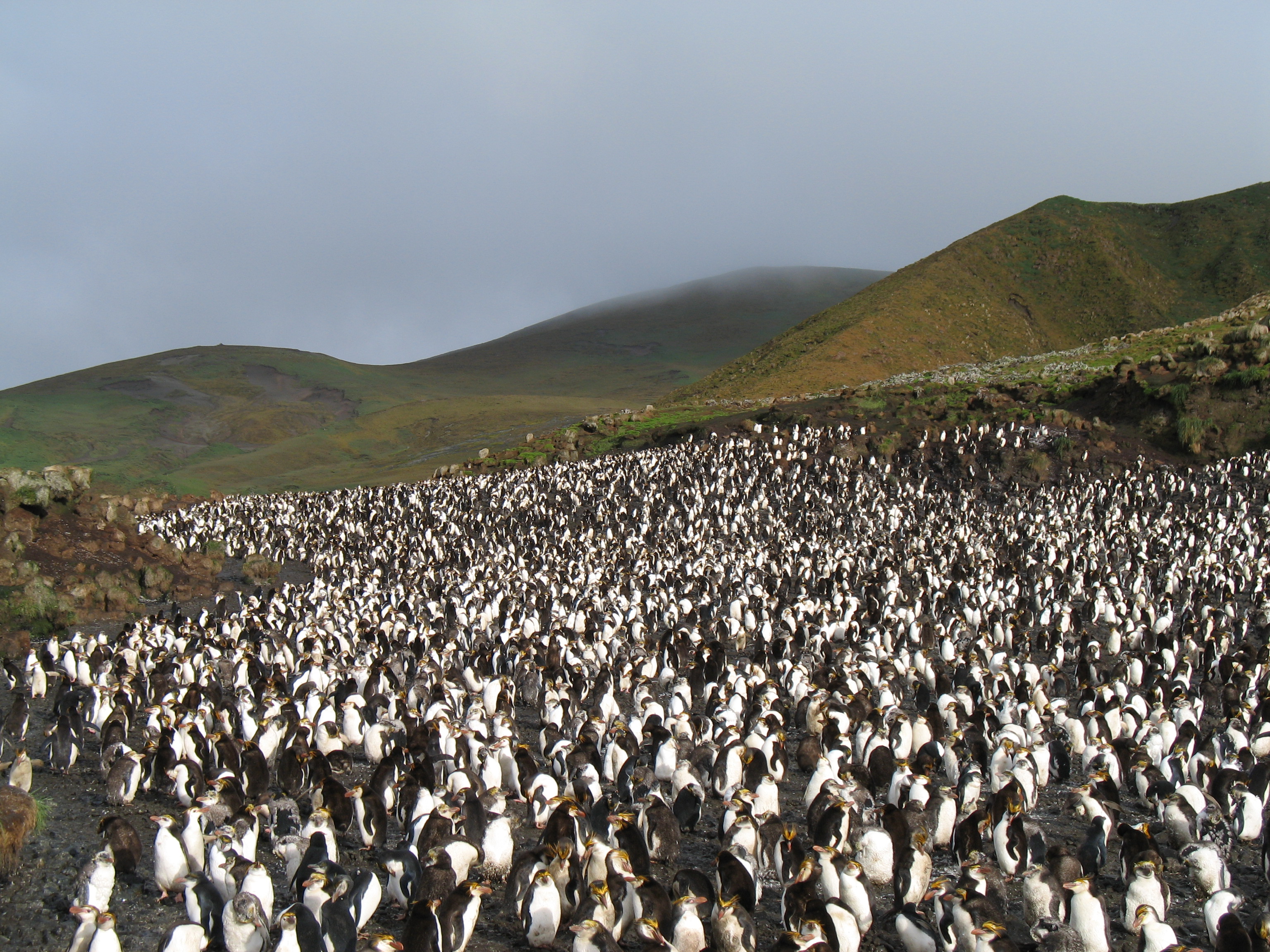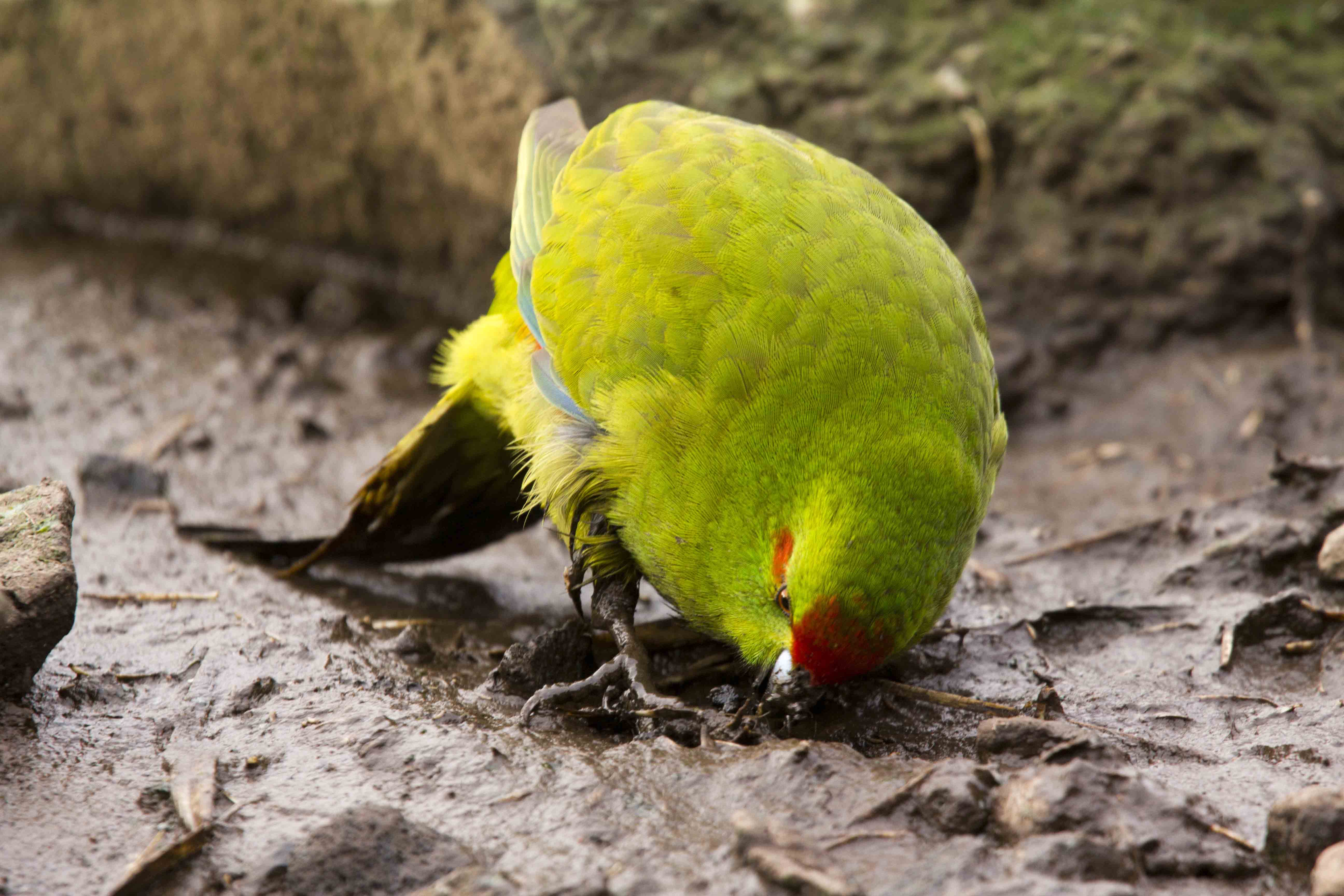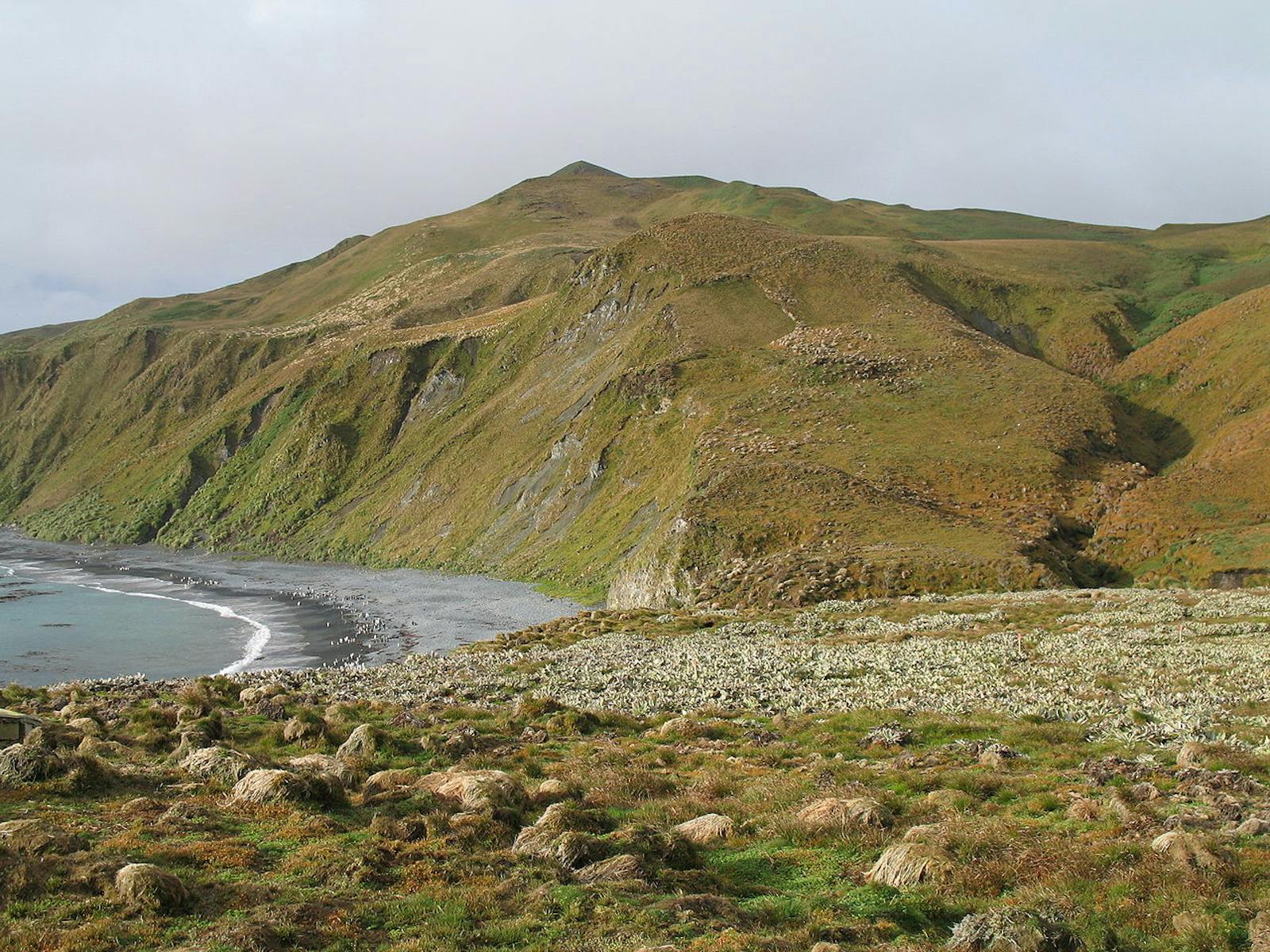Antipodes Subantarctic Islands Tundra
The ecoregion’s land area is provided in units of 1,000 hectares. The conservation target is the Global Safety Net (GSN1) area for the given ecoregion. The protection level indicates the percentage of the GSN goal that is currently protected on a scale of 0-10. N/A means data is not available at this time.
Bioregion: Subantarctic Antipodes Islands (AU16)
Realm: Australasia
Ecoregion Size (1000 ha):
88
Ecoregion ID:
196
Conservation Target:
100%
Protection Level:
10
States: New Zealand, Australia
This ecoregion consists of five island groups scattered across the cold, wet, and windy Southern Ocean south of New Zealand and Australia―Bounty Islands, Auckland Islands, Antipodes Islands, Campbell Island, and Macquarie Island. Here, megaherbs with giant and colorful flowers rise out of the long tussocks of grass characteristic of these island tundras. Two parakeets and the southernmost tree fern are residents, though the island ecologies are dominated by a rich community of marine mammals and birds, including many species of penguin and ten species of albatross.

The flagship species of the Antipodes Subantarctic Islands Tundra ecoregion is the Antipodes Island parakeet. Image credit: Kimberley Collins, Creative Commons
The Auckland, Campbell, and Antipodes Island groups are all volcanic in origin. Auckland and Campbell Islands are based on old shield volcanoes, with granite, greywacke, and schist basement rock exposed in many areas. The Bounty Islands are entirely composed of granite basement rocks. Macquarie Island is geologically distinct and lies on the Indo-Australian and Pacific Plate boundary.
The ecoregion also has different altitudes among the islands, from the 88-m peak on Bounty Islands to Antipodes Islands at 366 m and the Auckland Islands at 705 m. Topography also varies widely but is generally hilly. The climate on all these islands is wet, cold, and windy. They lie in a belt of the Southern Ocean lashed by a relentless cycle of westerly gales and cold fronts.
Mean wind speeds vary from 30 km/hr to 40 km/hr. Precipitation generally occurs on more than 300 days per year. Annual precipitation varies widely between islands but is less than 1,500 mm per year. Most islands have a mean annual temperature above 5°C and support trees and woody plants, except for Macquarie Island, which lies further south with a temperature below.

Royal Penguins rookery. Image credit: M. Murphy, Creative Commons
Most of the islands are either rocky with lichens or covered in a Chionochloa antartica and Poa foliosa tussock grass tundra interspersed with cushion plants and large, colorful herbaceous plants (Pleurophyllum spp., Stilocarpa polaris, Anistoma spp.) that have evolved into giant forms. The Auckland Islands and Campbell Island have some of the world's southernmost pockets of forests supporting southern rata (Metrosideros umbellata), Dracophyllum, Coprosma, and Myrsine species. The tree fern, Cyathea smithii, and orchid, Corybas dienemus, are living further south than any other in their taxa. The native flora has 260 species, with 35% found nowhere else, and many are restricted to single island groups.
The islands have 80 land birds with several endemics, including three parakeets (one extinct). The endemic Antipodes Island parakeet is one of the only five ground-dwelling parrots in the world and would occasionally prey upon other birds, an unusual trait for parrots. Marine birds are abundant, with 55 species recorded and several, such as the Bounty Island shag, restricted to the ecoregion.
Seabirds are also found in massive populations, with over 1.5 million endemic royal penguins (Eudyptes schelegli) found on Macquarie Island. Seven of the world’s 17 species of penguins breed in the region. 10 species or subspecies of albatross breed in the islands in the region, and five of them breed nowhere else: the Antipodean albatross, southern royal albatross, Campbell albatross, white-capped albatross, and Salvin’s albatross.
The ecoregion is also an important breeding site for marine mammals. Five species of pinnipeds breed on the islands, including the world's rarest, the New Zealand or Hookers sea lion. One of the main worldwide populations of southern elephant seals, as well as fur seals, leopard seals, crabeater seals, and Weddell seals, is also found here. There are no native land mammals or herpetofauna, though the invertebrate fauna shows a high level of endemism of butterflies (>50% endemic), moths, and beetles (many flightless), as well as large wetas (ground crickets).

Reischek's parakeet. Image credit: Creative Commons, API data Catalogue
The New Zealand Department of Conservation manages the Antipodes, Bounty, Auckland, and Campbell Islands, while Macquarie Island is managed by the Tasmanian Parks and Wildlife Service. Natural vegetation in this ecoregion still predominates, and although all habitat types are well represented and protected, introduced pigs, rabbits, weka (rail), cats, goats, cattle, sheep, rats, and mice have taken a toll on natural communities. Rabbits and pigs destroy fragile tundra vegetation. Rats, cats, pigs, and mice prey on native land and marine species.
The New Zealand and Australian managing agencies have quarantine procedures aimed at averting new introductions. Fishing activity is also a significant threat to many seabird and seal species.
The longline tuna fishing industry is a major cause of the global decline of albatross and some petrel species. Squid trawling around the Auckland Islands was estimated to kill over 100 New Zealand sea lions each year. Global climate change is also a potential threat. Changes in average temperature could spell disaster for marine and terrestrial species that utilize these islands, and terrestrial species are especially endangered. With such limited habitat available, they have little potential for migration to more suitable habitats.
Priority conservation actions that deserve continued support
- Eradicate introduced mammalian herbivores and predator species from priority islands.
- Reintroduce threatened species to islands clear of invasive species.
- Install fully fenced mice, cat, pig, and rat-proof enclosures to provide refuge to threatened invertebrate species.
-
-
- Given, DR, R Hnatiuk. 1995. Subantarctic Islands: Australia and New Zealand. Pages 516–518 in SD Davis, VH Heywood, AC Hamilton. editors. Centres of Plant Diversity. Volume 2. Asia, Australasia, and the Pacific. WWF/IUCN, IUCN Publications Unit, Cambridge, UK.
- O'Connor, T. editor. 1999. New Zealand's Sub-Antarctic Islands. Department of Conservation. Reeds, New Zealand.
- Springer, K. 2019. Antipodes Subantarctic Islands tundra. World Wildlife Fund. https://www.worldwildlife.org/ecoregions/aa1101 accessed on 1 June 2019.
-
Cite this page: Antipodes Subantarctic Islands Tundra. Ecoregion Snapshots: Descriptive Abstracts of the Terrestrial Ecoregions of the World, 2021. Developed by One Earth and RESOLVE. https://www.oneearth.org/ecoregions/antipodes-subantarctic-islands-tundra/
-



